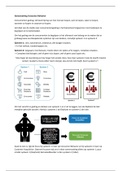Essay
Voices Conventions Comparison Essay (Speech and Reportage)
- Institution
- PEARSON (PEARSON)
Speech and Reportage conventions comparison essay from the English Language and Literature Voices anthology for Pearson Edexcel A-Level exam board. Following exam structure and technique with in-depth knowledge of the generic conventions of writing forms.
[Show more]




